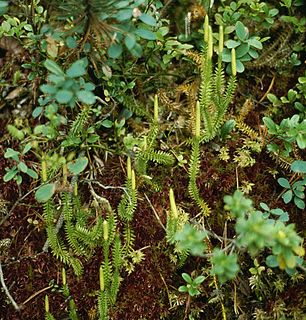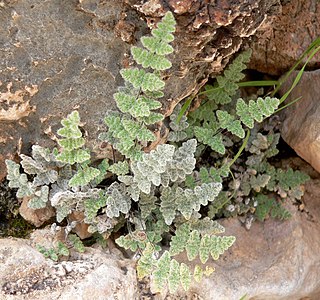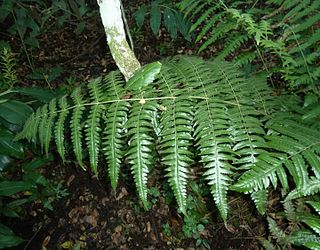Related Research Articles

Lycopodiopsida is a class of herbaceous vascular plants known as lycopods, lycophytes or other terms including the component lyco-. Members of the class are called clubmosses, firmosses and quillworts. They have dichotomously branching stems bearing simple leaves called microphylls and reproduce by means of spores borne in sporangia on the sides of the stems at the bases of the leaves. Although living species are small, during the Carboniferous, extinct tree-like forms formed huge forests that dominated the landscape and contributed to coal deposits.

Selaginella is the sole genus of vascular plants in the family Selaginellaceae, the spikemosses or lesser clubmosses.

Isoetes, commonly known as the quillworts, is the only extant genus of plants in the family Isoetaceae, which is in the class of lycopods. There are currently 192 recognized species, with a cosmopolitan distribution but with the individual species often scarce to rare. Some botanists split the genus, separating two South American species into the genus Stylites, although molecular data place these species among other species of Isoetes, so that Stylites does not warrant taxonomic recognition. Species of Isoetes virtually identical to modern forms have existed since the Jurassic epoch.

Huperzia is a genus of lycophyte plants, sometimes known as the firmosses or fir clubmosses; the Flora of North America calls them gemma fir-mosses. This genus was originally included in the related genus Lycopodium, from which it differs in having undifferentiated sporangial leaves, and the sporangia not formed into apical cones. The common name firmoss, used for some of the north temperate species, refers to their superficial resemblance to branches of fir (Abies), a conifer. As of 2020, two very different circumscriptions of the genus were in use. In the Pteridophyte Phylogeny Group classification of 2016, Huperzia is one of three genera in the subfamily Huperzioideae of the family Lycopodiaceae. Most species in the subfamily are placed in the genus Phlegmariurus. Huperzia is left with about 25 species, although not all have been formally transferred to other genera. Other sources recognize only Huperzia, which then has about 340 species.

The Lycopodiaceae are an old family of vascular plants, including all of the core clubmosses, comprising 16 accepted genera and about 400 known species. This family originated about 380 million years ago in the early Devonian, though the diversity within the family has been much more recent. "Wolf foot" is another common name for this family due to the resemblance of either the roots or branch tips to a wolf's paw.

Cheilanthes is a genus of about 180 species of rock-dwelling ferns with a cosmopolitan distribution in warm, dry, rocky regions, often growing in small crevices high up on cliffs. Most are small, sturdy and evergreen. The leaves, often densely covered in trichomes, spring directly from the rootstocks. Many of them are desert ferns, curling up during dry times and reviving with the coming of moisture. At the ends of veins sporangia, or spore-bearing structures, are protected by leaf margins, which curl over them.

Lycopodium is a genus of clubmosses, also known as ground pines or creeping cedars, in the family Lycopodiaceae. Two very different circumscriptions of the genus are in use. In the Pteridophyte Phylogeny Group classification of 2016, Lycopodium is one of nine genera in the subfamily Lycopodioideae, and has from 9 to 15 species. In other classifications, the genus is equivalent to the whole of the subfamily, since it includes all the other genera. There are then more than 40 accepted species.

Lycopodiella is a genus in the clubmoss family Lycopodiaceae. The genus members are commonly called bog clubmosses, describing their wetland habitat. The genus has a cosmopolitan, with centers of diversity in the tropical New World and New Guinea. In the past, the genus was often incorporated within the related genus Lycopodium, but was segregated in 1964. In the Pteridophyte Phylogeny Group classification of 2016, Lycopodiella is placed in the subfamily Lycopodielloideae, along with three other genera. In this circumscription, the genus has about 15 species. Other sources use a wider circumscription, in which the genus is equivalent to the subfamily of PPG I, in which case about 40 species and hybrids are accepted.

Phlegmariurus is a genus of lycophyte plants in the family Lycopodiaceae. The genus is recognized in the Pteridophyte Phylogeny Group classification of 2016, but not by some other sources, which keep it in a broadly defined Huperzia.

Blotiella is a genus of ferns in the family Dennstaedtiaceae described as a genus in 1962. The genus was named in honor of Marie Laure Tardieu-Blot.
- Blotiella coursii(Tardieu) Rakotondr. ex J.P.Roux 2009 - Madagascar
- Blotiella currorii(Hook.) R.M.Tryon 1962 - central Africa
- Blotiella glabra(Bory) R.M.Tryon 1962 - Madagascar, E + S Africa
- Blotiella hieronymi(Kümmerle) Pic.Serm. 1983 - Kenya, Tanzania
- Blotiella lindeniana(Hook.) R.M.Tryon 1962 - Central - South America
- Blotiella madagascariensis(Hook.) R.M.Tryon 1962 - Madagascar
- Blotiella mannii(Baker) Pic.Serm. 1977 - Cameroon
- Blotiella natalensis(Hook.) R.M.Tryon 1962 - E + SE + S Africa, Madagascar, Mauritius, Comoros
- Blotiella pubescens(Kaulf.) R.M.Tryon 1962 - Madagascar
- Blotiella reducta(C.Chr.) R.M.Tryon 1962 - Madagascar, tropical Africa
- Blotiella sinuataPic.Serm. 1983
- Blotiella stipitata(Alston) Faden 1974 - Kenya, Tanzania
- Blotiella tisserantii(Alston & Tardieu) Pic.Serm. 1983 - Cameroon, Gabon, Central African Republic

Lateristachys diffusa, synonym Lycopodiella diffusa, known as carpet clubmoss, is a species of clubmoss in the family Lycopodiaceae. It is indigenous to New Zealand and to Tasmania, Australia.

Pseudolycopodiella caroliniana, known as slender bog club-moss, is a species of lycophyte in the family Lycopodiaceae. The genus Pseudolycopodiella is accepted in the Flora of North America and the Pteridophyte Phylogeny Group classification of 2016, but not in other classifications, which submerge the genus in Lycopodiella. The species has a discontinuous distribution, being native to the eastern United States and to parts of eastern Asia.
References
- ↑ Rickards, R.B. (2000). "The age of the earliest club mosses: the Silurian Baragwanathia flora in Victoria, Australia". Geological Magazine. 137 (2): 207–209. Bibcode:2000GeoM..137..207R. doi:10.1017/s0016756800003800.
- ↑ McElwain, Jenny C.; Willis, K. G. (2002). The evolution of plants. Oxford, UK: Oxford University Press. ISBN 978-0-19-850065-0.
- ↑ Ranker, T. A.; Hauler, C. H. (2008). Biology and evolution of ferns and lycophytes. Cambridge: Cambridge University Press.
- ↑ Butler, Rhett A. (1 July 2019). "Total number of plant species by country". Mongabay. Retrieved 21 July 2019.
- ↑ "Vegetation of South Africa". PlantZAfrica.com. SA National Biodiversity Institute. Retrieved 24 July 2019.
- 1 2 3 4 5 6 7 8 9 10 11 12 13 14 15 16 17 18 19 20 21 22 23 24 25 26 27 28 29 30 31 32 33 34 35 36 37 38 39 40 41 42 43 44 45 46 "species_checklist_20180710.csv". South African National Biodiversity Institute. Retrieved 27 September 2020.